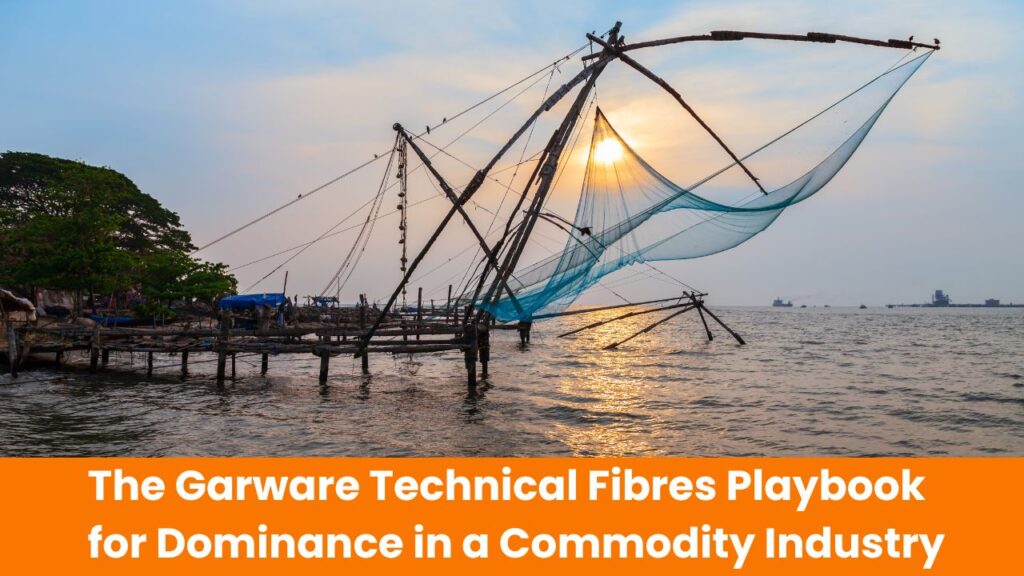In the world of technical textiles, where fierce competition and razor-thin margins are the norm, standing out is no small feat. Yet, Garware Technical Fibres Limited (GTFL) has managed to do just that, transforming from a humble manufacturer of nylon fishing nets into a global leader with a diverse product portfolio and a reputation for innovation. How did they achieve this in such a cutthroat industry?
The answer lies in their strategic approach—leveraging partnerships, pioneering new technologies, and building a brand that commands loyalty and premium prices. This article takes you through GTFL’s journey, exploring the strategies that have enabled them to thrive where many others have struggled, and offering insights into how they’ve created a resilient business model that continues to dominate the technical textiles sector.

To give you a well-rounded understanding of Garware Technical Fibres, we’ve structured our analysis into five key sections:
What We Will Cover
A Look Back: Company History
Founded in 1976 as Garware Wall Ropes, the company began by manufacturing nylon fibers for fishing nets, focusing on commoditized products like ropes and twines primarily for the fisheries industry. From 1990 to 2011, GTFL diversified into industries like sports and agriculture, marking their shift away from commodity-based products.
Under the leadership of Vayu Garware, who became CMD in 2011, the company transformed into a global technical textiles player with multiple divisions, significantly increasing its R&D investment—up sixfold from FY11 to FY22—which drove innovations that boosted profitability.
To enhance its operational capabilities, GTFL brought in industry professionals like COO-turned-CEO Shujaul Rehman and Alex Sutherland, formerly of Marine Harvest, and adopted advanced manufacturing practices like Kaizen and Total Process Management to improve shop floor efficiency.
Product Portfolio and Its Applications
Garware Technical Fibres is renowned for its high-performance products across various industries. Here’s a snapshot of their key segments:
- Fisheries: GTFL holds a commanding 65% market share in India’s fisheries industry. Their products, like Seine and Trawling nets, have been key in achieving world-record catches, allowing them to charge premium prices that are 25-30% higher than competitors.
- Aquaculture: Since entering this market in 2004, GTFL has become a global leader, holding a 95% share in Canada’s salmon farming industry. They patented technologies such as V2 and X12.
- Geosynthetics: GTFL supplies technical textiles for infrastructure projects. While this sector relies heavily on government spending, these products are essential for stabilizing rocks near railway tracks and other critical infrastructure needs.
- Shipping and Mooring Ropes: GTFL’s ropes, made with Dyneema technology, are claimed to have been ten times stronger than traditional steel ropes, benefiting major clients like Adani Ports, the Indian Navy, and the Indian Coast Guard.
- Sports Nets: From Wimbledon to the English Premier League, Garware’s sports nets are used.
- Defense and Agriculture Nets: GTFL also offers products for the defense industry, such as aerostat fabrics and sleeping bags. In agriculture, their protective nets hold significant growth potential, given the current low market penetration in India.
Building Mini Moats: How GTFL Stays Ahead
Garware Technical Fibres (GTFL) has managed to create several “mini moats”—strategic advantages that help the company maintain its strong market position. Let’s break down how they’ve done it.
1. A Robust Distribution Network
One of GTFL’s key strengths is its vast distribution network. With over 3,000 dealers spread across India, GTFL ensures its products are always within reach in one of the world’s largest markets. This extensive network allows the company to enter new markets quickly, meet customer needs efficiently and keep a strong presence across various regions.
But GTFL’s reach isn’t limited to India. They’ve formed strategic partnerships with key players in international markets like Norway and Scotland—major hubs for fishing and aquaculture. These partnerships help GTFL expand globally, making sure their products are available where they’re needed most.
2. Technical Know-How and Innovation
GTFL’s investment in research and development has paid off, giving the company a competitive edge. By 2022, they had filed 75 patents, with 23 already granted—an impressive portfolio that showcases their innovation prowess.
Two of their standout innovations are the V2 and X12 technologies. These proprietary products are a direct result of GTFL’s focus on R&D and have become synonymous with high performance, durability and reliability in the fishing and aquaculture industries. This kind of innovation helps set GTFL in creating differentiation in the industry.
3. Diverse Product Portfolio
Another key advantage GTFL has is its diverse product portfolio. With over 20,000 SKUs (Stock Keeping Units), they offer a wide range of specialized products across multiple industries, including fishing, aquaculture, agriculture, sports and shipping. This diversity allows GTFL to meet the varied needs of its customers while also creating significant barriers for competitors trying to enter the market.
The broad range of products also allows GTFL to cross-sell, strengthen customer relationships and offer integrated solutions that keep customers coming back.
4. Strong Brand Reputation
GTFL has built a solid brand reputation over the years, thanks to its focus on “what they do best”. This strong brand allows GTFL to command premium prices in several industries. Customers know the Garware brand stands for reliability, durability and innovation which leads to strong customer loyalty and repeat business.
In industries where the quality of materials can make or break operations—like fishing and aquaculture—the trust in Garware’s products is a game-changer. This brand strength not only helps GTFL maintain its market share but also opens doors to new markets and industries.
5. Strategic Partnerships
GTFL has wisely cultivated strategic partnerships, especially in the aquaculture and shipping industries. These collaborations have expanded GTFL’s capabilities, allowing them to tap into the expertise, technologies and market access of their partners.
For instance, their partnerships in Norway and Scotland—regions known for advanced aquaculture practices—have enabled GTFL to stay on top of the latest industry trends and integrate that knowledge into their products. These strategic alliances give GTFL a competitive edge in terms of innovation and market reach, helping them co-develop products, enter new markets more effectively and offer tailored solutions that meet the specific needs of different regions and industries.
Wrap Up
Garware Technical Fibres has built strong moats in a commoditized industry through strategic innovation, a robust distribution network, and a strong brand reputation. Their application of first principles thinking has played a crucial role in addressing core industry challenges and driving the development of high-margin, proprietary products. In a tough industry, GTFL has not only survived but thrived by carving out its niche and building a resilient business model.
Disclaimer: Garware Technical Fibress Limited (GTFL) is a public limited company listed on stock exchanges. The information provided in this article is for general informational purposes only and does not constitute investment advice or an endorsement of any kind. We do not recommend or endorse any specific investments or securities. Please consult with a qualified financial advisor before making any investment decisions.
- 5C’s of Marketing : Explained Through Chef’s POV - September 24, 2024
- Garware Technical Fibres’ Strategy : Weaving Success and Thriving in a Commodity Industry - September 2, 2024
- How D2C Brands in India Are Transforming Traditional Retail (Hint : Technology) - August 30, 2024



